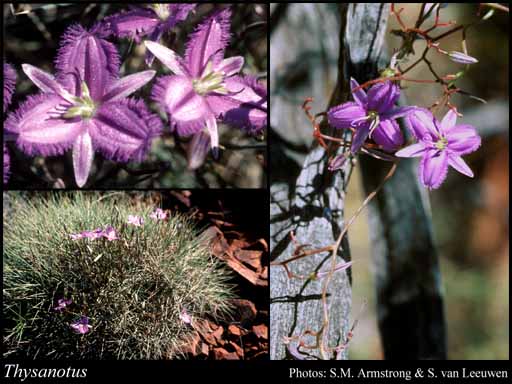- Reference
- Prodr.Fl.Nov.Holland. 282 (1810)
- Name Status
- Current

Scientific Description
Family Anthericaceae.
Sometimes included in Liliaceae.
Habit and leaf form. Herbs (tufted or twining); evergreen, or deciduous. Perennial (leaves perennial, or annual often withering early). Leaves basal. Plants with a basal concentration of leaves, or with neither basal nor terminal concentrations of leaves; rhizomatous, or tuberous (may also lack a perennating organ). Self supporting, or climbing. Mesophytic, or xerophytic. Leaves alternate; spiral, or distichous; ‘herbaceous’, or leathery, or membranous; sessile; sheathing. Leaf sheaths not tubular; with free margins. Leaves edgewise to the stem, or with ‘normal’ orientation; simple. Leaf blades entire; flat, or solid (adaxial surface grooved or channelled); terete; linear, or lanceolate, or oblong, or ovate; parallel-veined; without cross-venules; sheathing. Leaves ligulate, or eligulate; without stipules. Leaf blade margins entire. Leaf anatomy. Hairs present, or absent. Extra-floral nectaries absent. Stem anatomy. Secondary thickening absent.
Reproductive type, pollination. Fertile flowers hermaphrodite. Unisexual flowers absent. Plants hermaphrodite. Floral nectaries present. Nectar secretion from the gynoecium (from septal nectaries).
Inflorescence and flower features. Flowers solitary, or aggregated in ‘inflorescences’; in umbels. The terminal inflorescence unit cymose, or racemose (simple or compound). Inflorescences scapiflorous; terminal (or rarely lateral); flowering stems annual or perennial; scape present or absent, leafless or nearly so, simple or branched; inflorescence a terminal umbel or cymose umbels or a panicle of umbels, 5–50 flowers often loosely arranged; with involucral bracts, or without involucral bracts; pseudanthial, or not pseudanthial. Flowers pedicellate (articulate below the middle); bracteate (short, inconspicuous, imbricate, scarious); ebracteolate; small, or medium-sized; regular, or somewhat irregular (stamens to one side); 3 merous; cyclic; pentacyclic, or tetracyclic. Perigone tube absent. Perianth with distinct calyx and corolla (the whorls rather different), or of ‘tepals’; 6; 2 -whorled (3+3); isomerous; free; petaloid; similar in the two whorls, or different in the two whorls; green, or purple, or blue. Perianth members fringed (inner segments), or entire (outer segments). Calyx (if the outer whorl so interpreted) 3; 1 -whorled; regular. Corolla (if the inner whorl so interpreted) 3; 1 -whorled; regular. Corolla members fringed. Androecial members definite in number. Androecium 3, or 6. Androecial members free of the perianth; all equal, or markedly unequal (outer anthers shorter); free of one another; 1 -whorled, or 2 -whorled. Androecium exclusively of fertile stamens. Stamens 3, or 6; all more or less similar in shape; isomerous with the perianth, or diplostemonous; on the receptacle, outer stamens when present opposite the outer perianth segments, inner stamens opposite the inner perianth segments; alterniperianthial, or oppositiperianthial. Anthers basifixed (or nearly so); dehiscing via pores, or dehiscing via longitudinal slits (full length); introrse; tetrasporangiate. Gynoecium 3 carpelled. The pistil 3 celled. Carpels isomerous with the perianth. Gynoecium syncarpous; synstylovarious, or eu-syncarpous; superior. Ovary plurilocular; 3 locular; sessile. Gynoecium stylate. Styles 1; apical (or nearly so). Stigmas 1; 2–3 - lobed. Placentation axile. Ovules 2(–20) per locule; arillate, or non-arillate; campylotropous (generally), or anatropous.
Fruit and seed features. Fruit non-fleshy; dehiscent; usually a capsule. Capsules loculicidal. Fruit 3 celled; 3–6 seeded. Seeds endospermic. Cotyledons 1. Embryo straight to curved.